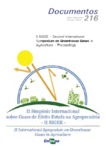Por favor, use este identificador para citar o enlazar este ítem:
http://www.alice.cnptia.embrapa.br/alice/handle/doc/1066156| Título: | Effect of energy source inclusion in diet on methane production of cattle determined by sulphur hexafluoride (SF6) tracer gas technique. |
| Autor: | SOLORZANO, L. A. R.  MARINO, C. T.   RODRIGUES, P. H. M.   BERNDT, A.   PINEDO, L. A.   FRIGHETTO, R. T. S.   OLIVEIRA, P. P. A.   PRAES, M. F. F. M.   |
| Afiliación: | LAURA ALEXANDRA ROMERO SOLÓRZANO, FMVZ-USP; CAROLINA TOBIAS MARINO, FMVZ-USP; PAULO HENRIQUE MAZZA RODRIGUES, FMZV-USP; ALEXANDRE BERNDT, CPPSE; LERNER AREVALO PINEDO, FMVZ-USP; ROSA TOYOKO SHIRAISHI FRIGHETTO, CNPMA; PATRICIA PERONDI ANCHAO OLIVEIRA, CPPSE; MARIA FERNANDA FERREIRA MENEGUCCI PRAES, FMVZ-USP. |
| Año: | 2016 |
| Referencia: | In: INTERNATIONAL SYMPOSIUM ON GREENHOUSE GASES IN AGRICULTURE, 2., 2016, Campo Grande, MS. Proceedings... Brasília, DF: Embrapa, 2016. |
| Páginas: | p. 235-240. |
| Descripción: | Abstract: Ruminant animals have a great advantage over simple-stomached animals, as their digestive process is able to release the energy contained in cellulosic material through carbohydrate fermentation by microorganisms enzymes from the rumen environment. However, carbohydrate fermentation results not only in short chain fatty acids (SCFA) but also in less desirable products such as heat, as well as methane (CH4) and carbon dioxide (CO2) gases which represents energy loss for the animal estimated in 2 to 12% of gross energy from feed (Johnson and Johnson, 1995). As an adult ruminant can produce up to 17 liters of methane per hour and this gas cannot be metabolized even by rumen microorganisms, most of it is removed from rumen by expiration or eructation (Moss, 1993), and released in the environment. There are different techniques for methane emissions measurements by ruminants in production conditions; among them there is one that uses an inert gas tracer, sulphur hexafluoride (SF6). This technique results in a precise estimative of methane production by the animal besides enabling the evaluation of animals in normal pasture conditions, it consists in placing a permeation tube, which releases SF6 at a previously known rate in the rumen, where by the contractions of this organ, CH4 and SF6 gases are released by eructation and samples are collected close to mouth and nostrils. This method assumes that the standard of SF6 emission simulates the standard of CH4 emission. The flow of CH4 released by the animal is calculated in relation to SF6 flow (Westberg et al., 1998).The objective with the present study was to evaluate energy sources inclusion in cattle diets on methane production determined by sulphur hexafluoride (SF6) tracer gas technique. |
| Thesagro: | Bovino Efeito estufa Metano Nutrição animal |
| NAL Thesaurus: | Cattle Sulfur hexafluoride Methane Greenhouse gas emissions Tracer techniques |
| Citación: | (Embrapa Gado de Corte. Documentos, 216) |
| Tipo de Material: | Resumo em anais e proceedings |
| Acceso: | openAccess |
| Aparece en las colecciones: | Resumo em anais de congresso (CPPSE)  |
Ficheros en este ítem:
| Fichero | Descripción | Tamaño | Formato | |
|---|---|---|---|---|
| Effectenergysources.pdf | 337,17 kB | Adobe PDF |  Visualizar/Abrir |









